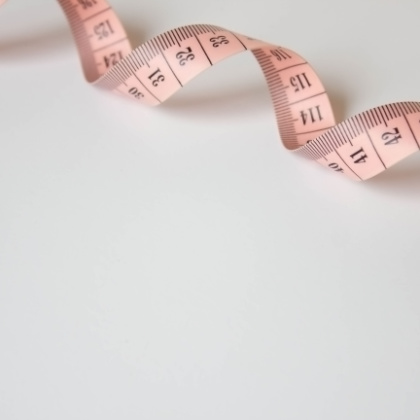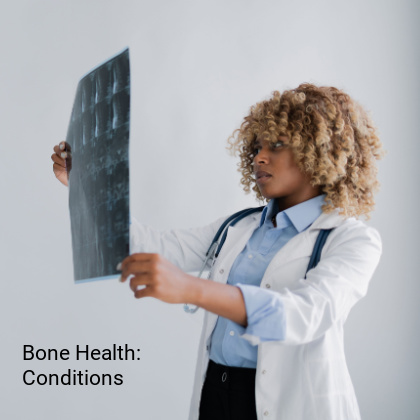
Over the last few decades bone health has become an increasingly popular subject with medical experts and researchers. We now know so much more about the subject than we used to, such as why having strong bones is so important to our health or our understanding of osteoporosis – a condition causing fragile bones that affects around 22 per cent of women and seven per cent of men aged 50 or older in the UK (i).
There are medical treatments for osteoporosis, including drugs designed to maintain and improve bone density. However, some experts claim these treatments aren’t completely effective (ii). And that, they say, is why it’s important to take steps whenever possible to prevent osteoporosis and other bone conditions by being more aware of bone health and by having a healthy lifestyle.
In fact, there’s so much you can do to promote and protect your own bone health, not just as you get older but throughout your lifetime.
How to maintain strong and healthy bones
The main things you can do to keep your bones strong and healthy at any age are
-
Eat a well-balanced diet that contains a range of nutrients important for health, including bone health nutrients such as calcium, vitamin D, vitamin K and protein
-
Stay active on a daily basis, including doing strength and weight-bearing activities
-
Maintain a healthy weight, as being underweight or obese are associated with poorer bone health (read our article Bone health: why weight matters to find out why)
Experts suggest lifestyle factors that contribute to good bone health can help prevent the onset of many other major chronic diseases (iii). In other words, what’s good for your bones is good for the rest of you too.
Exercise for strong and healthy bones
Staying active can help you manage your weight and keep it in the normal range, which is important for healthy bones. But exercise itself is an important way of preventing and reducing bone density decline too.
Certain types of activities are particularly effective at helping to keep bones healthy: according to the Royal Osteoporosis Society, combining weight-bearing exercise with impact and muscle strengthening exercise is the best approach (iv).
Exercise is also important for bone growth in children, with the International Osteoporosis Foundation suggesting young bones respond even more to exercise than adult bones, and that children and adolescents who exercise regularly show a significant increase in bone mass (v). This is important, since having good bone health when you’re young is linked with having good bone health during your later years too (read our article Bone health through the ages to find out more).
Weight-bearing exercises
Weight-bearing activities are those that you perform while supporting the weight of your body. Meanwhile weight-bearing exercise with impact involves being on your feet and adding an additional force or jolt through your skeleton through jumping or skipping, for instance. This can range from low to high-impact.
-
Low-impact weight-bearing activities include walking, marching, water aerobics, low-impact aerobics and stair climbing.
-
Moderate-impact weight-bearing activities include skipping, hopping, jogging, running, hiking, team and racket sports, weight lifting or resistance training and dancing.
-
High-impact weight-bearing activities – the most effective activities – include star jumps, tuck jumps, track events, gymnastics, volleyball and basketball. Doing just five to 10 minutes of these types of activities may be enough to provide bone health benefits, say experts (iii).
Muscle strengthening exercises
Muscle strengthening exercises include moves such as squats and lunges as well as exercises using weights including leg presses, chest presses, deadlifts and bicep curls. Heavy gardening – for instance, digging and shovelling – lifting and carrying children, wheeling a wheelchair and even carrying heavy bags of shopping can also improve your muscle strength.
How much exercise should you do to support healthy bones?
Official UK recommendations for physical activity are slightly different for different age groups.
Recommended exercise for adults aged 19-64
-
Adults aged 19 to 64 are advised to do some type of physical activity every day. This includes:
-
Muscle strengthening activities that work all the major muscle groups at least twice a week
-
150 minutes of moderate activity a week, spread out evenly over four or five days, or every day. Alternatively, you could do 75 minutes of vigorous activity a week (examples include running, sports such as football, rugby, netball and hockey, stair climbing, aerobics, gymnastics, skipping and martial arts). Meanwhile you could also mix moderate and vigorous activity (or even short sessions of very vigorous activity such as lifting heavy weights, circuit training, interval running and spinning classes) to achieve your weekly target
-
Reducing time spent sitting or lying down, including breaking up long periods of not moving with some activity
Recommended exercise for adults aged 65+
Adults aged 65 and older should also try to be active every day, even if they can only take part in light activities such as moving around their home, cleaning and dusting, standing up and making their bed. Other recommendations include:
-
Muscle strengthening activities that work all the major muscle groups as well as exercises that improve balance and flexibility at least twice a week – these will help you feel more confident on your feet so you’re less likely to have a fall
-
150 minutes of moderate activity a week such as walking, riding a bike, dancing, playing doubles tennis or hiking (or 75 minutes of vigorous activity a week, or a combination of both)
-
Limiting the time spent sitting or lying down, including breaking up long periods of not moving with some activity
Children ages five years+ and teenagers
Children aged five years upwards and teenagers should aim for at least 60 minutes of moderate or vigorous activity a day, including a variety of different types and intensities of activities (including activities that strengthen their muscles and bones). They too should try to reduce the time they spend sitting or lying down.
Whatever your age, if you’re new to exercise or you haven’t been very active lately, start slowly, and build up your fitness levels gradually. Always speak to your GP before starting any new exercise regime if you have a medical condition.
What alcohol and smoking do to your bones
Most of us already know that if we want to stay healthy in general it’s a good idea to stick to safe drinking guidelines and to avoid smoking. That same advice also applies to our bone health. But what makes drinking too much alcohol and smoking bad for your bones?
Drinking excessive amounts of alcohol may affect how well your body absorbs nutrients, including calcium and vitamin D. It may also interfere with your production of hormones, this can affect your bones too, since testosterone is involved in making cells that stimulate bone formation and oestrogen is thought to help prevent bone breakdown as well as promote bone formation.
Another hormone that can be affected by heavy drinking is parathyroid hormone. Drinking alcohol may make your body produce too much of it, which can cause calcium loss from your bones and reduce your bone density.
Indeed, according to Osteoporosis Canada there’s evidence to suggest that people who regularly drink three or more alcoholic drinks a day have an increased risk of developing osteoporosis (vi).
How much alcohol is safe for bone health?
The UK’s Chief Medical Officers’ guidelines on low-risk drinking state that to keep health risks from alcohol low, both men and women should drink no more than 14 units a week (vii). They also recommend that, if you regularly drink as much as 14 units a week, it’s advisable to spread your drinking over three or more days and to have several drink-free days each week.
What do 14 units look like?
-
Six pints of average-strength beer
-
Six medium (175ml) glasses of average-strength wine
-
14 single measures (25ml) of spirits (vodka, gin, whisky etc)
Find out more about the units in different types of drinks as well as tips on cutting down on your alcohol intake by reading our guide
Smoking and bone health
Most people are aware of the health risks of smoking – particularly when it comes to heart health, cancer and respiratory health. But the chemicals in cigarettes such as nicotine are bad for your bones too, making you more susceptible to developing osteoporosis.
Like alcohol there are several ways smoking can affect bone health:
-
It reduces your body’s ability to absorb calcium
-
It reduces the blood flow to your bones, which restricts their oxygen supply
-
It inhibits the production of cells that stimulate bone formation
-
It also interferes with your hormone balance – causing lower oestrogen levels, for instance
Researchers confirm that both firsthand and secondhand smoke has a negative impact on bone health, which means you could be affected if you live or work with a smoker but don’t smoke yourself (viii). However, they also say that giving up smoking seems to reverse the effect of smoking and improves bone strength.
If you’re thinking of quitting, read our guide to stop smoking for advice and tips.
Nutrition for strong and healthy bones
To make sure your diet is bone-friendly, you need a good supply of nutrients including calcium, vitamin D, vitamin K and protein.
Calcium
Around 99 per cent of the calcium in your body is found in your bones – in fact, it’s the calcium that gives your bones their hardness and strength.
Calcium-rich foods for bones:
-
Dairy foods including milk, cheese and yoghurt (goat’s milk and sheep’s milk are also good calcium sources)
-
Calcium-fortified plant-based alternatives to milk, cheese and yoghurt
-
Calcium-fortified breakfast cereals
-
Tinned sardines, pilchards and salmon with bones
-
Broccoli, kale, spring greens and other green leafy veg (but not spinach)
-
Bread and other products made with calcium-fortified flour
Vitamin D
Vitamin D is an important bone health nutrient because it helps your body to absorb calcium from the food you eat (even if you eat plenty of foods that contain calcium, if you don’t get enough vitamin D it’s unlikely your bones will be as strong and healthy as they should be).
Vitamin D is also sometimes called the sunshine vitamin because your skin makes its own vitamin D when it’s exposed to sunlight. In fact, this is where we get most of our vitamin D from, rather than from food. That’s because only a limited number of foods contain vitamin D.
Vitamin D foods for bones
-
Oily fish
-
Egg yolks
-
Meat and offal
-
Fortified foods such as breakfast cereals, margarine, yoghurt and plant-based milks
Unfortunately we don’t get much strong sunlight in the UK during the autumn and winter months. That’s why the government advises everyone to consider taking a daily 10 microgram vitamin D supplement at these times of year – plus those at high risk of not getting enough vitamin D should think about taking a supplement at all times.
There are two main forms of vitamin D found in foods and supplements – D2 (ergocalciferol) and D3 (cholecalciferol). Vitamin D3 is the type that your skin makes when it’s exposed to sunlight.
Vitamin K
The body needs vitamin K to make important bone proteins that help keep your bones strong. But it also helps the calcium absorbed by your body to get where it’s needed – that is, into your bones and teeth – while directing it away from soft tissues such as your heart, kidneys and brain (where it can cause problems).
Vitamin K foods for bones
-
Plant foods including leafy greens such as spinach, kale and Swiss chard, as well as broccoli, asparagus, Brussel sprouts and plant oils
-
Animal-based foods including meat, dairy foods and eggs
-
Fermented foods including sauerkraut, kefir and natto (a fermented soya food)
Find out more about vitamin K and its role in bone health by reading our article Bone health: the importance of vitamin K.
There’s also information about the relationship between calcium, vitamin D, vitamin K and bone health in our article Bone health: how calcium, vitamin D and vitamin K work together.
Protein
Most of us know how important protein is for our muscle health. But it’s essential for our bones too – in fact where bones are concerned you could say protein is just as important as calcium and vitamin D.
Benefits of protein for bones
-
Protein provides your body with the amino acids it needs to build and maintain bone tissue (your bones contain collagen, which is a type of protein)
-
It also increases your body’s production of a hormone called insulin-like growth factor-1 (IGF-1), which promotes bone formation (IGF-1 may also help your body absorb calcium from food)
-
Protein suppresses the production of parathyroid hormone, large levels of which can trigger the release of calcium from bones into the bloodstream
-
By improving muscle strength and mass, protein helps build and maintain bone density
Foods high in protein
Sources of protein include meat and meat products, dairy products, fish, eggs, nuts, soya, beans, peas, lentils, cereals and grains. You can also boost your protein intake by drinking protein shakes or adding protein powders to your meals – these can be convenient for those who struggle to get enough protein through food alone.
To find out more about protein – including why it’s good for bone health and more on the foods it’s found in – read our article Bone health: the importance of protein.
Magnesium
This helps keep bones hard and rigid. Indeed, 70 per cent of the body’s magnesium is stored in the bones and teeth. Magnesium also helps convert vitamin D into the form that boosts calcium absorption in the body. Many people, however, may not be getting enough magnesium in their diet (sources include nuts, seeds, green leafy veg, whole grains, beans and lentils).
If you’re looking for a magnesium supplement, choose a form that’s absorbed more readily than others such as magnesium citrate.
Vitamin C
Vitamin C is necessary for bones because it contributes to normal collagen formation. Researchers suggest the ways in which vitamin C affect our genes is important for bone formation, and that it may help prevent common bone-degenerating conditions (x). Vitamin C is found in a wide variety of fruit and vegetables, but a good-quality supplement can help make sure you’re getting it in good amounts.
Zinc
The mineral zinc is thought to play an important role in bone metabolism and mineralisation (xi). Scientists also claim zinc is an essential mineral required for normal skeletal growth, and that it may also be able to promote bone regeneration (xii). Like magnesium, the citrate form of zinc is thought to be better absorbed by the body than some other forms. You can also try getting more zinc-rich foods in your diet such as dairy foods, shellfish, meat, bread and wheat germ.
Find out more about bone diseases
To find out more about bone health including how your lifestyle can help keep your bones strong and healthy, visit the bone health section of our pharmacy health library. You can also find more details about the most common bone health condition – including what you could do to help prevent it – in our guide to osteoporosis.
References:
-
Available online: https://www.osteoporosis.foundation/sites/iofbonehealth/files/scope-2021/UK report.pdf
-
Sheng B, et al.. The relationship between healthy lifestyles and bone health. Medicine (Baltimore). 2021 Feb 26;100(8):e24684. Available online: https://www.ncbi.nlm.nih.gov/pmc/articles/PMC7909112/
-
Bone Health and Osteoporosis: A Report of the Surgeon General. Available online: https://www.ncbi.nlm.nih.gov/books/NBK45523/
-
Available online: https://theros.org.uk/information-and-support/living-with-osteoporosis/exercise-and-physical-activity-with-osteoporosis/
-
Available online: https://www.osteoporosis.foundation/sites/iofbonehealth/files/2019-03/2017_BuildingStrongBonesInYouth_Brochure_English.pdf
-
Available online: https://osteoporosis.ca/position-statements/alcohol-intake-and-bone-health/
-
Available online: https://www.drinkaware.co.uk/facts/alcoholic-drinks-and-units/low-risk-drinking-guidelines
-
Al-Bashaireh A, et al.. The Effect of Tobacco Smoking on Bone Mass: An Overview of Pathophysiologic Mechanisms. J Osteoporos. 2018; 2018: 1206235. Available online: https://www.ncbi.nlm.nih.gov/pmc/articles/PMC6304634/
-
Tripkovic L, et al.. Comparison of vitamin D2 and vitamin D3 supplementation in raising serum 25-hydroxyvitamin D status: a systematic review and meta-analysis. Am J Clin Nutr. 2012 Jun;95(6):1357-1364. Available online: https://www.ncbi.nlm.nih.gov/pmc/articles/PMC3349454/
Glendenning P, et al.. Calculated free and bioavailable vitamin D metabolite concentrations in vitamin D-deficient hip fracture patients after supplementation with cholecalciferol and ergocalciferol. Bone. 2013 Oct;56(2):271-5. Available online: https://www.sciencedirect.com/science/article/abs/pii/S8756328213002305?via=ihub -
Thaler R, et al.. Vitamin C epigenetically controls osteogenesis and bone mineralization. Nat Commun. 2022 Oct 6;13(1):5883. Available online: https://www.nature.com/articles/s41467-022-32915-8
-
Amin N, et al.. Zinc supplements and bone health: The role of the RANKL-RANK axis as a therapeutic target. J Trace Elem Med Biol. 2021 Jan;57:126417. Available online: https://www.sciencedirect.com/science/article/abs/pii/S0946672X19304134
-
O’Connor JP, et al.. Zinc as a Therapeutic Agent in Bone Regeneration. Materials. 2020 May;13(10):2211. Available online: https://www.ncbi.nlm.nih.gov/pmc/articles/PMC7287917/
Related Posts
Disclaimer: The information presented by Nature's Best is for informational purposes only. It is based on scientific studies (human, animal, or in vitro), clinical experience, or traditional usage as cited in each article. The results reported may not necessarily occur in all individuals. Self-treatment is not recommended for life-threatening conditions that require medical treatment under a doctor's care. For many of the conditions discussed, treatment with prescription or over the counter medication is also available. Consult your doctor, practitioner, and/or pharmacist for any health problem and before using any supplements or before making any changes in prescribed medications.

Christine
Christine Morgan has been a freelance health and wellbeing journalist for almost 20 years, having written for numerous publications including the Daily Mirror, S Magazine, Top Sante, Healthy, Woman & Home, Zest, Allergy, Healthy Times and Pregnancy & Birth; she has also edited several titles such as Women’ Health, Shine’s Real Health & Beauty and All About Health.
View More



